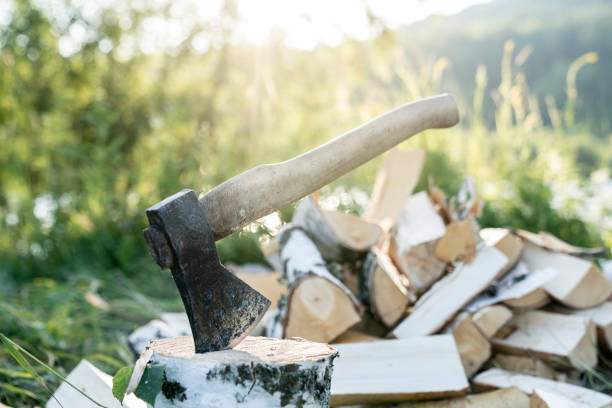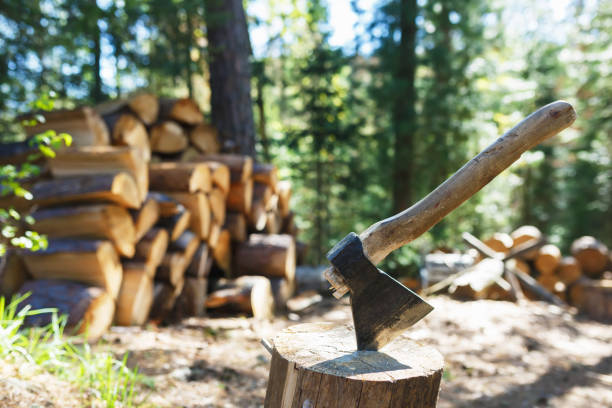Axes have a long history of use in weaponry, hunting, and felling trees. Today, the axe is mostly used in the yard or for outdoor activities like camping, but the kind of axe you need will depend on the use you have in mind for it.
The felling axe, also known as the American axe, is the most widely used axe in use today. Felling axes come in a wide variety of styles, and their blade patterns are given names based on the places where they were made. The following patterns are among them.
Common Patterns of Axes
Dayton Axe
Dayton, Ohio serves as the inspiration for the name of this pattern. The blade is slightly flared and curved. It is a well-liked pattern that works well for routine outdoor ax jobs.
New England Axe
This axe has a bottom edge that is slightly bearded and a top edge that is straight across.
Michigan Axe
It first gained popularity in the 1860s and is now a typical shape for felling axes. Its curved head makes it perfect for chopping big trees and hard wood.
Connecticut Axe
This common axe head design resembles a wedge with a slight flare to it. For everyday policing tasks, it works wonderfully.
Things You Should Consider When Searching for a Perfect Axe
Handle
Despite the fact that more and more big box stores are selling axes with rubber handles, the best axes have wooden handles. The ergonomics and durability of a wooden handle are superior. Look for a handle made of hickory or ash for the best quality.
Weight
The use of the axe head will be impacted by its weight. It won’t cut very deeply if it’s too light, but if it’s too heavy, you’ll gain force but lose accuracy. With more experience, you can progress to heavier bits, but for your first axe, the head shouldn’t weigh more than three pounds.
Size
The size of an axe handle should depend largely on how it will be used. This is a hotly debated issue. When it comes to a felling axe, a longer handle will result in a bigger swing and more leverage, while a shorter handle will produce better accuracy. Full-sized felling axes typically measure 36 inches in length, but for most users, this should be the maximum length to take into account. A handle measuring about 32 inches would be ideal for a person who is six feet tall because it will provide a good balance between accuracy and force.
Various Types of Axes
Tactical Axe
A modern invention that functions somewhat like a multi-tool is the tactical axe. This axe, also referred to as a tactical tomahawk, is becoming more and more popular among law enforcement officers, soldiers, security personnel, and survivalists. This axe is primarily used for chopping, but it can also be used as a shovel, a pry bar, a hammer, and a close-range weapon. As it can assist with cooking, cutting wood for campfires, and digging holes, it is perfect for camping trips. These axes are typically made of steel so they have the durability to handle a variety of tasks.
Grub Axe
Grub axes have heads with an axe on one side and an adze on the other, and they are also referred to as “cutter mattocks.” The longer of the two blades, the adze, will be at a horizontal angle while the axe blade will be at a vertical angle. The term “grub axe” refers to the tool’s method of use because it works well for grubbing in rocky, compacted soil. These implements can be used to break up stubborn roots of older plants or dig holes to plant new plants, making them very helpful in the garden.
Felling Axe
These axes are made especially for chopping wood logs and felling trees. A felling axe’s head weighs two to four pounds and rests at the end of a long handle. This long handle gives the user more leverage and a stronger swing, which results in a better cut. Hickory, a sturdy wood, has historically been used to make the handles. For maximum strength, the hickory grain should curve and follow the length of the handle.
A felling axe’s blade has a flared shape and a point that is thin and sharp. These are made to cut against the grain of the wood, so when felling a tree, it should be swung sideways at the tree trunk. Felling axes work well for their intended purpose of felling small trees and branches, but they are not the best choice for splitting because their blades have a tendency to get stuck in the wood.
Forest Axe
Axes made specifically for cutting down trees are called forest axes. It would be great to keep them permanently at a cabin in the woods, but they are very heavy-duty tools and are too big to bring along on camping trips. These axes have exceptionally long handles and are designed to feel like very big trees. A forest axe will have a pointed blade that is sharp and flared with a slightly rounded tip.
Hudson Bay Axe
Canadian fur trappers created this particular style of the medium-sized axe. On lengthy journeys to the chilly north, they used it to chop firewood and as a general-purpose axe for other jobs. Its size falls somewhere between that of a hatchet and a full-sized felling axe. It works well for smaller chopping and splitting tasks and can be used with one hand or both. However, due to its size, camping trips are more manageable even though it won’t be much use on larger trees.
Hatchet
Most people own a hatchet, which is a general all-purpose axe used for simple tasks in the yard. From a few dollars to more than $100, their cost can vary greatly. In comparison to some other axes, they are fairly small and have a thick handle that is typically made of hickory wood. The weighted head has a flared shape that ends in a blade with a sharp tip. A good hatchet must have balance because it will produce more accurate swings and cuts, which will speed up and simplify the completion of tasks. In addition to splitting and chopping logs, a hatchet is used to fill small trees.

Splitting Maul
These axes were created specifically to cut logs into kindling. With a long wooden handle to provide a good swing, they have a design that is very reminiscent of a felling axe. When using a splitting maul, you should swing it downward rather than sideways like you would with a felling axe. Splitting mauls produce split wood as opposed to chopped wood, in contrast to felling axes, which cut against the grain of the wood. A splitting maul’s head weighs about eight pounds, which is significantly more than a felling axe.
The blade’s shape and weight will do the majority of the work, so the head is shaped like a thick wedge with one sharp end and one blunt end. However, the sharp end doesn’t need to be particularly sharp in order to be functional. Since splitting mauls can function effectively even when fairly blunt, they require much less frequent sharpening than other axes.
Broad Axe
The term “broad axe” also refers to a tool used primarily for hewing, which is the conversion of round-edged lumber into flat-edged timber. Before there were industrial sawmills, this kind of carpentry was frequently employed. This axe has a broad, beveled-edged blade on one side with a flat side for hewing and a flat side for chopping. It is a medium-sized hand tool that is now frequently used by carpenters and infrequently seen in general use.
Carpenter’s Axe
A carpenter’s axe is a craftsman’s tool that is intended for fine woodworking and isn’t the best choice for routine felling or chopping tasks. This is a small axe that is occasionally referred to as a carpenter’s hatchet, despite being a little larger than a typical hatchet. Traditionally, this kind of axe would have a flat butt that served as both a hammer and a flat, razor-sharp blade. The blade of a carpenter’s axe is crucial when choosing one to use because a straighter edge is a sign of a higher quality axe that will make a better and more accurate cut. Additionally, modern carpenter’s axes feature a groove that can be used to pry nails out of wood. Additionally, they frequently have a notch on the handle for improved grip and more precise control by the user.
Miner’s Axe
In the Middle Ages, miners in Europe used this axe to extract copper and silver ore from the ground. These axes are made for use in confined spaces because they have a short handle and long head. These axes may have had highly detailed engraving on the head that became a status symbol among miners over the years.
Double Bit Axe
The double-bit axe has two blades, one on each side of the head. These are typically symmetrical from the front, but one blade will be dull and the other sharp. The blunt side was used to split the wood into small pieces that could be used as kindling for a fire, while the sharp side was used to chop wood or fell trees. Now only used by lumberjacks, these axes are no longer produced on a large scale.
Being very heavy and having a double head makes them difficult to carry. Due to the additional weight of the extra head, many people choose not to use them because doing so causes the user to become exhausted more quickly than usual. The double-bit axe’s advantage, however, is that it essentially combines two separate axes into one, saving you from having two separate axes.
Viking Axe
Throughout the entirety of the Viking Age, axes were used in combat. You wouldn’t be right to assume that Viking axes were brutish and heavy, despite the fact that many of them were large. Axes made by the Vikings were often exceptionally well-balanced and rarely weighed more than two pounds, making them easy to carry and use quickly in combat. These axes came in a wide range of sizes, but the majority were double-handed and had handles that extended to 55 inches.
Viking axe heads may have had a variety of shapes, but they are most famous for having thick beards. This form was helpful in combat for a number of purposes, such as hooking an opponent’s ankle to knock them over or hooking their shield out of the way to leave them defenseless. Extremely sharp blade tips would be used to slit throats like knives, and a blunt axe’s butt would also be used to strike targets in the head for humiliating but non-lethal blows. Iron was almost always used to make the heads, while wood was typically used to make the handles. These kinds of axes are no longer in use; instead, they are studied to uncover information about ancient cultures.

Tomahawk
Axes called tomahawks are North American in origin, where Native Americans first employed them. Since their inception, both sides have used them in combat, first in the American Revolution and then in the Vietnam War. They have a long military history. Hatchet-like in appearance, these axes are noticeably lighter and have a completely straight handle. They are easier to throw during combat because of their straight handles, and their sharp blades can be used for a variety of tasks, such as digging, prying, chopping, and splitting. Tomahawks are popular among soldiers, but more recently, they have also become popular for camping. They are easier to carry around because they are smaller and lighter than hatchets. They can be used for many different bushcraft activities because they are multipurpose. In competitions for throwing knives, where they have their own division, tomahawks are also frequently used.
Pick Axe
A pickaxe is a hand tool with a T-shaped shape.’ It has a double metal head at the top and a wooden or fiberglass handle. Traditionally, the pick would be on both sides of the head; however, modern pickaxes typically have a pointed pick on one side and a chisel on the other. The pick end can occasionally be curved or completely straight. The chisel is frequently used to pry open cracks in the ground or gaps between rocks, whereas the pickaxe is a helpful tool for gardening and landscaping that is primarily used for breaking up hard soil, rocks, or concrete. In addition to acting as a weight to balance the axe, the chisel also gives the pick more momentum when it is swung.
Roofing Axe
A roofing axe also referred to as a roofing hatchet, is a high-quality craftsman’s tool that is used in roofing. Despite modern inventions making it less popular, many roofers still favor this traditional roofing tool. A roofing axe serves multiple functions, which is great if you’re on top of a roof and don’t want to be carrying around a lot of different tools. On either side of the handle of the roofing, axe are two heads. A razor-sharp blade on one head is used to cut roofing shingles.
For driving roofing nails into the roof to attach the shingles, the other head of the tool is a hammer. Frequently, the hammerhead will be magnetized, allowing you to merely attach the nails to the front of the hammer and ram them in without holding them in place. A node on the side with a sharp blade is an additional feature of roofing axes. With the hammerhead pointing upward, you can use this node, a shingle gauge, by hooking it over the front face of the shingle beneath the one you are setting. You should achieve evenly spaced rows of shingles by having the following shingle sit up against the hammerhead.
Hunter’s Axe
A hunter’s axe, which can be used to both chop wood and meat, is a necessity. A good hunter’s axe will have a grooved handle that improves grip even when the user’s hands are wet or sticky, whether from rain or animal blood. The straight blade and sharp corners of a regular axe would not be ideal for skinning an animal because they could accidentally harm the hide. The rounded “flay poll” on a hunter’s axe, in contrast, will be more practical for skinning animals. In order to purchase a hunter’s axe, you would need to locate a specialized forger.
Throwing Axe
The original throwing axe was a weapon in battle used by foot soldiers in the middle ages. It was thrown at an adversary to deal fatal damage. Axe throwing has gained popularity as a competitive sport in recent years since it was first introduced. The axes used in this sport can be of a variety of types and designs, but their most important quality is that they need to be incredibly strong and durable to withstand the pressure from repeated throws.
In order to comply with the rules established by the league or federation hosting the sport, the handle of a throwing axe must be a specific length. Depending on your skill level, you can purchase a variety of axes for throwing, such as beginner to intermediate axes or more sophisticated axes for more seasoned axe throwers. The cost of these axes ranges, but generally speaking, the more you spend, the higher quality axe you will get.
Crash Axe
In the event of an airplane crash landing, an emergency tool called a crash axe is frequently used. These axes are hand-held tools with a short handle and a razor-sharp smooth or serrated blade. When entering the aircraft from the outside or, in the event that all other exits are blocked, cutting a hole in the aircraft from the inside, the blade must be able to cut through sheet metal. A crash axe can also chop interior walls and overhead cabinets and pry gaps open. In the event of an emergency, every aircraft with 20 or more passenger seats must have a crash axe in the cockpit. Others might have a separate head with a pick on it. Some crash axe types have a notch on the blade that can be used to hook onto sheet metal. Outside of the emergency services, no one else typically owns these kinds of axes, which are typically made entirely of metal.

Adze
Technically, an adze is any hand tool with a cutting edge, but the first adzes were made in the Stone Age. These ancient instruments are typically used for woodworking, to smooth and carve wood. An adze’s blade is very sharp and is set at a right angle for precise and intricate carpentry. There are many different kinds of adzes, but they can be divided into two groups: hand adzes and foot adzes. A hand adze has a short handle so that it can be swung with just one hand. A foot adze has a longer handle and is meant to be swung with both hands. The term “foot adze” refers to where the head typically lands, which is at or near foot or shin height.
Summary: Variety to Choose
We hope you have enjoyed reading about the many different axes and have learned about a few new ones. We advise purchasing a tactical ax or a felling ax if you’re looking for an ax type for your home because they are the most practical for a variety of uses. However, if you have a specific task that needs to be finished, you should purchase the best tool for the job.

